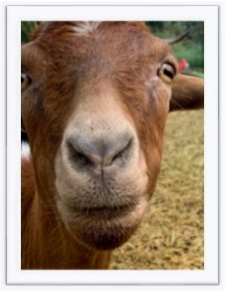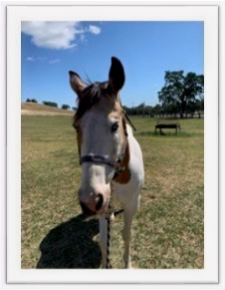General Happenings at the Ranch
As daylight lingers longer into the evenings, the horses will begin to be fed later in the day. Many studies have shown that feeding horses at varying times reduces the stress that can arise when they are habituated to constant feeding at set times. Also being fed later in the evening reduces the amount of time between dinner and breakfast feedings. This is a good thing as horses are designed to eat continuously throughout the entire 24-hour day.
Rigo’s goats had baby’s aka kids. If you haven’t gone down there to check them out, do so. They are pretty darn cute.
Welcome and Goodbye to Boarders
We said goodbye to Will, Fancy, and Topaz this month. They went to live in a 15-acre pasture in Martinez. The news on Topaz is that she is doing great, adjusting to the change like a champ and stealing the hearts of those who get to know her with that cute face! They will all be missed.
Charm, formally known as Cinnamon, has joined the general population after a period of quarantine. She is settling in nicely and is quite happy in her new life. She is living in Topaz’s old spot, paddock #17.
Welcome Mary Caswell and Romeo. Romeo is a palomino Morgan-quarter horse cross. He is being patient and getting settled in. Soon he will live in paddock #12 and join the general population. He has allergies so if you hear him cough, don’t be alarmed. The vet has diagnosed him with allergies and hopefully he can adjust soon. It was snowing where he came from when he moved across the country to us. Just to be safe he will stay in quarantine until late next week.
Improvements
Bats living in the grain room: We are trying to address the bat population that has taken up residence in the grain room. Bats are great for the economy but not so good around our horse’s feed. We installed boards to deter them and will be working a bit more on further solutions so stay tuned.
General maintenance: Some months it takes time to just keep things running smoothly. Water tanks washed, lots of weed whacking, and keeping the place safe and clean.
Irrigation: We are on top of irrigation this year, the pump was removed and sent away for service. It has been reinstalled and the lines tested. Now we have to wait for the folks at dam to release enough water to fill our canal so we can pump to irrigate.
Safety Issues
Fire season preparation: A spreadsheet is up in the main barn to help organize what horses will be evacuating with whom in what trailer and so forth. Lots of new people, and others have left so we will need to reorganize the evacuation procedure in regards to this. Please fill out the spreadsheet and we can move forward with planning a fire drill. Emergency evacuation procedures will remain the same as far as the route of ingress and exit.
Arena holes: We are trapping the critter making holes in our arena. Most likely it is a ground squirrel or possibly moles. Once we catch them and take them far away, we will repair the surface areas and remove the cones that are up marking the current holes. Thank you for your patience with this.
Reminders
Spring vaccinations are due for many horses. The yolo county vector has been monitoring the west Nile count in our area as it is high this year as well as the mosquito that is a vector for dingo fever! If you see or are bit by very small mosquitoes during the daylight hours, please let Laura know so she can contact the vector to set traps and spray.
A spreadsheet is in the main barn for boarders to write in their vaccination dates for our records. It is important that we have this in case something should arise that we are required to report to the county. Please take a moment to fill it out for us and if you haven’t scheduled your horse for its spring shots, and if they need them, please do so.
Photo's of the Month
Fun Facts About Horse Care or Horse Health
How to read your horse’s vital signs, why it is important, and what are normal ranges.
Temperature
The normal rectal temperature of an adult horse is 99.5 to 101.5°F (37.5 to 38.6ºC). In general, not 100% of all situations, a temperature reading of 102.5 is when it is recommended that your vet be called for a field visit.
It is important to have a baseline temperature for your horses. Just like people, horses can have varying internal temperatures. Knowing your own horse’s baseline temperature will help you determine when something has arisen that might be more serious such as infection or sickness.
To get a baseline temperature, take temperatures in the early a.m. and early evening such as 6 p.m. After a few days of readings; you have a baseline to refer back to should you feel your horse seems “low”, “off” or “punky”.
Remember to lubricate the thermometer, stand at a safe place next to your horse should they be averse to it (not behind them). Press the thermometer against the side wall of the anus so that you are not just taking a reading of the temperature of their poop but of the actual horse’s body.
Also temp reading will vary with the seasons, so don’t be alarmed with triple digit heat if the baseline rises or drops during winter.
Respiratory Rate
A normal respiratory rate for an adult horse is 8-15 breaths per minute (bpm). Respiration should consist of inhalation and exhalation, which should be of equal length. Heat, humidity, exercise, fever, and pain can cause an increase in the respiratory rate.
Watch as your horse’s chest moves in and out, or place your hand on his chest to feel it move in and out. Count the number of breaths for fifteen seconds, and multiply by four.
A high respiratory rate, increased effort when inhaling or exhaling, or noise when breathing should prompt a call to your veterinarian.
Heart Rate
The normal heart rate of an adult horse at rest is 30-40 beats per minute (bpm). A horse’s heart rate will be higher if he is excited, in pain, has certain diseases, or has just exercised.
To take your horse’s heart rate you can either use a stethoscope to listen to his heart or feel his pulse on his facial artery or digital artery. These two arteries are easy to find for most people. The facial artery runs along the outside of the bottom of his jawbone. The digital artery runs on the outside of his leg at the level of his fetlock. Press down gently over the artery to feel the pulse. to use a stethoscope, place it on your horse’s chest just behind the elbow. You can count the number of beats in fifteen seconds and multiply by four.
Heart rates not associated with exercise, especially if combined with abnormal behavior should be taken seriously. Any heart rate over 40 bpm warrants a call to your veterinarian. A heart rate over 60 bpm indicates a severe condition and should be treated as an emergency.
Gut Sounds
Horse’s intestines are in almost constant motion and that results in constant noise from them. Sometimes the sounds may be quieter than others, but they are always there. Excessive sounds may indicate irritation or inflammation of the intestines, as in the case of diarrhea. The absence of gut sounds can indicate a serious problem, such as colic.
Place your stethoscope on either side of your horse’s flank and listen for gurgling, gassy, and “fluidy” sounds. You should be able to hear these on both sides. You can also place your ear to your horse’s flank and listen if you don’t have a stethoscope. Most horses have loud enough gut sounds that you can hear them even without a stethoscope.
If your horse has no gut sounds and any other signs such as loss of appetite, fever, pawing, or laying down, contact your veterinarian.
Capillary Refill Time (CRT)
Capillary Refill Time (CRT) is the time it takes for blood to return to blanched tissues in the gums. This is an indicator of blood circulation. Normal refill time is one to two seconds.
To check your horse’s CRT, lift his upper lip and press on his gums. Count how long it takes for the normal pink to come back to the area you pressed.
If your horse’s CRT is three seconds or more it can indicate poor circulation, dehydration, or illness. Contact your veterinarian.
Mucus Membrane Color
Mucus membranes are the tissues that line the eyelids, lips, gums, nostrils, and vulva. The color of the mucus membranes is another indicator of blood circulation. Healthy mucous membranes are a moist pink. They can sometimes have a pale-yellow tinge to them as well. Dry mucous membranes may signal dehydration.
Color can indicate various conditions:
Very pale pink: blood loss, anemia
White: severe blood loss anemia, shock
Bright red/red purple: toxicity, mild shock
Gray/Blue: severe shock, decreased oxygen
Bright yellow: Liver disease
If your horse’s mucus membranes are any of the above, contact your veterinarian immediately
Knowing what is normal for your horse will help you determine when things are NOT normal.
Digital Pulse
The digital pulse is the pulse that can be felt as blood flows through the artery into a horse’s hoof. If there is any inflammation of the tissues in the leg or hoof the blood flow will be restricted making the pulse stronger and easier to feel. A pulse that is easy to find and is bounding (a throbbing sensation much like a headache or smashed finger) may be an early indicator that there is some sort of injury to the hoof or lower leg, making the digital pulse an important diagnostic tool.
It is a good idea to find out what your horse’s normal digital pulse is when they are sound. To do this take your horse’s pulse before exercising each morning for at least a week and then periodically after that. When you are familiar with your horse’s normal digital pulse it will be more evident to you when it is irregular.
A strong pulse in one hoof can be an indicator of infection or of an injury such as an abscess, bruise, or an injury in the leg above the hoof. A strong pulse in two or more legs accompanied by hoof tenderness can be an indicator of laminitis, especially if they are rocking back off their front feet to bear more weight on their hind feet.
A digital pulse on a horse with no hoof or lower limb injuries will be hard to find, so don’t worry if you can’t find it when your horse is sound. When feeling for the digital pulse use the index and middle fingers of your hand. Do not use your thumbs, your thumbs have a pulse of their own much like your wrist or your neck and you will end up feeling your own pulse instead of your horse’s. The pulse can be felt on both the outside and inside of the leg from just above the fetlock, over the fetlock, and down the pastern.
Cartoon of the Month











Comments